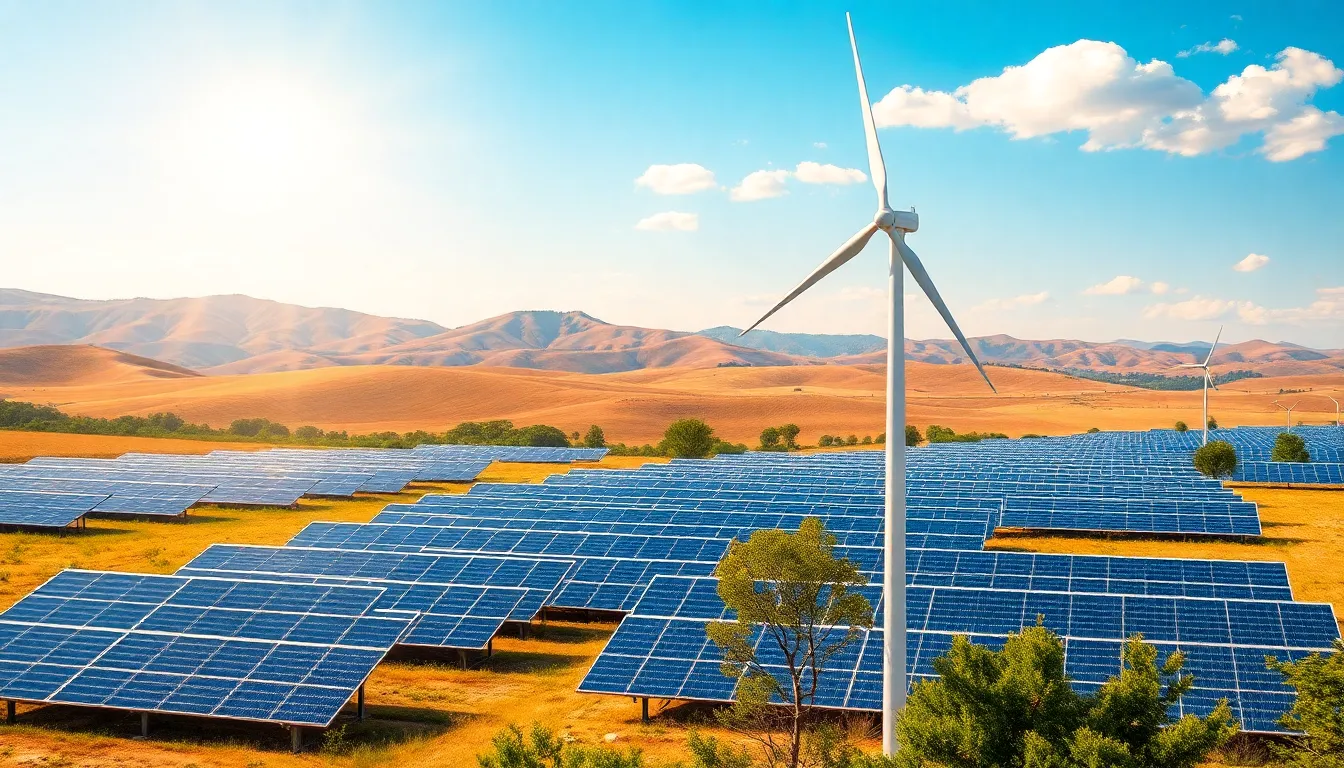In a world where fossil fuels are about as popular as a rainy day at a picnic, clean energy conversion is stepping onto the scene like a superhero in a spandex suit. It’s not just about saving the planet; it’s about making energy fun, efficient, and—dare we say—cool. Imagine harnessing the sun and wind to power your gadgets without the guilt of contributing to climate change. Sounds like a sci-fi dream, right?
But this isn’t just a fantasy. Clean energy conversion is transforming how we think about power. It’s time to leave behind the dirty energy habits of the past and embrace a future where renewable sources reign supreme. Buckle up as we explore the ins and outs of clean energy conversion, and discover why it’s not just a trend, but a necessity for a sustainable and vibrant future.
Table of Contents
ToggleOverview of Clean Energy Conversion
Clean energy conversion encompasses the processes that transform renewable energy sources into usable power. This transformation addresses the pressing need for sustainable energy solutions. Solar energy captures sunlight through photovoltaic cells, generating electrical energy efficiently. Wind energy harnesses air currents using turbines to produce electricity with minimal environmental impact.
Bioenergy, derived from organic materials, offers another pathway for clean energy conversion. It can be transformed into fuels, electricity, or heat, providing a sustainable option for diverse energy needs. Hydropower exploits the kinetic energy of flowing water, contributing significantly to global electricity supply.
Innovative technologies further enhance clean energy conversion. Energy storage systems, like batteries, help balance supply and demand, ensuring consistent energy availability. Smart grid solutions optimize energy distribution, integrating various renewable sources seamlessly.
According to the International Energy Agency (IEA), renewables contributed over 30% of global electricity generation in 2020 and are projected to exceed 50% by 2030. These figures illustrate the rapid growth and pivotal role of clean energy in the global energy landscape.
Adopting clean energy conversion methods can significantly help reduce greenhouse gas emissions. Transitioning to renewables further encourages energy independence, stimulating economic growth and job creation in emerging sectors. Investing in clean technologies offers a clear path toward a sustainable future, benefiting both the environment and society as a whole.
Types of Clean Energy Conversion

Clean energy conversion encompasses multiple methods to transform renewable resources into usable energy. Each type plays a vital role in reducing dependency on fossil fuels and promoting sustainability.
Solar Energy Conversion
Solar energy conversion employs photovoltaic cells to capture sunlight and generate electricity. These cells, often made from silicon, convert solar radiation directly into electrical energy. Innovations in solar technology have improved efficiency, resulting in higher energy yields. Ground-mounted and rooftop systems offer versatility for different installations. The National Renewable Energy Laboratory (NREL) indicates that solar photovoltaic installations contributed over 109 gigawatts to the U.S. electricity grid by the end of 2020. Adoption continues to rise, making solar a key player in the transition to clean energy.
Wind Energy Conversion
Wind energy conversion utilizes turbines to harness kinetic energy from wind currents. Turbines consist of blades that rotate in response to wind, driving a generator that produces electricity. Modern wind farms can range from a few turbines to hundreds, maximizing land use and energy production. According to the U.S. Department of Energy, wind energy provided around 8.4% of the total electricity generation in the U.S. by 2020. Continued advancements in turbine design and placement lead to increased efficiency and output.
Bioenergy Conversion
Bioenergy conversion generates energy from organic materials, such as plant and animal waste. This method includes burning biomass or converting waste into biogas through anaerobic digestion. Facilities can produce heat, electricity, or biofuels from these processes, promoting waste reduction. The U.S. Energy Information Administration (EIA) notes that bioenergy accounted for about 5% of total U.S. energy consumption in 2020. Innovation in bioenergy techniques also enhances potential as a sustainable energy source.
Hydropower Conversion
Hydropower conversion relies on flowing water to generate electricity, typically through dams or run-of-river systems. Water flow spins turbines connected to generators, producing consistent and reliable energy. This method supplies approximately 31% of the world’s renewable electricity, according to the International Hydropower Association. Enhanced technologies like underwater turbines and small-scale hydropower projects increase accessibility and reduce environmental impact. Hydropower continues to be a cornerstone in the clean energy landscape.
Technologies in Clean Energy Conversion
Clean energy conversion employs various technologies to transform renewable sources into usable power. These technologies play a crucial role in advancing sustainable energy solutions.
Photovoltaics
Photovoltaic cells capture sunlight and convert it into electricity. These cells generate power by exploiting the photovoltaic effect, where sunlight energizes electrons in semiconductor materials. As of 2020, solar installations added over 109 gigawatts to the U.S. electricity grid. They contribute significantly to the national energy mix, aiding the transition to a cleaner energy future. Advances in solar panel efficiency continue to enhance their effectiveness and affordability.
Wind Turbines
Wind turbines harness the kinetic energy of wind and convert it into electricity. Turbines rotate when air currents strike their blades, generating mechanical power that transforms into electrical energy through a generator. In 2020, wind energy accounted for roughly 8.4% of total U.S. electricity generation. The continued deployment of larger and more efficient turbines increases wind energy capacity. Offshore wind developments further extend the potential for harnessing sustained wind resources.
Bioenergy Systems
Bioenergy systems generate energy from organic materials like plants and animal waste. These systems convert biomass through various processes, including combustion and anaerobic digestion, to produce electricity, heat, or fuels. In 2020, bioenergy accounted for about 5% of total U.S. energy consumption. Utilizing waste materials for energy reduces landfill use and promotes circular economy practices. This approach highlights a sustainable energy strategy that benefits both environment and economy.
Hydroelectric Systems
Hydroelectric systems utilize flowing water to produce electricity. Dams allow water to flow through turbines, generating power as the water releases energy. Approximately 31% of the world’s renewable electricity comes from hydropower. This reliable and efficient source supports grid stability and energy security. Environmental considerations in hydroelectric projects ensure minimal impact on ecosystems while promoting renewable energy growth.
Benefits of Clean Energy Conversion
Clean energy conversion offers significant advantages for the environment and the economy. Addressing the threats posed by climate change, this transition to renewable energy is crucial for a sustainable future.
Environmental Impact
Clean energy significantly reduces greenhouse gas emissions, providing a healthier atmosphere. Solar and wind power generation produces zero emissions during operation, making them vital in combating climate change. Additionally, renewable energy sources preserve natural resources by decreasing reliance on fossil fuels. Protecting ecosystems and reducing air pollution leads to improved public health outcomes, reflecting a broader commitment to environmental stewardship.
Economic Advantages
Clean energy conversion spurs economic growth through job creation in the renewable sector. Reports indicate that solar energy alone generated over 250,000 jobs within the U.S. by 2020. Lower energy costs result from increased efficiency and competition in the clean energy market. Energy independence strengthens national security by reducing reliance on foreign oil, contributing to a more self-sufficient economy. Investing in clean energy also promotes innovation, paving the way for further advancements in technology and infrastructure.
Challenges in Clean Energy Conversion
Clean energy conversion faces various challenges that impede its widespread adoption. These hurdles can stem from technological barriers and policy-related issues.
Technological Barriers
Technological barriers hinder the efficiency and effectiveness of clean energy conversion. The current limitations in energy storage systems affect the ability to capture and utilize energy generated by renewable sources. Innovations in battery technology remain essential for storing energy from intermittent sources like solar and wind. High initial costs associated with the deployment of renewable infrastructure can deter investment. Moreover, issues related to grid integration may lead to inefficiencies in energy distribution. Advancements in energy conversion technologies, such as photovoltaic efficiency and turbine design, continue to evolve but require further research and funding to fully realize their potential.
Policy and Regulatory Issues
Policy and regulatory issues pose significant challenges to clean energy conversion efforts. Uncertainty in government policies can create obstacles for investors and developers looking to finance renewable projects. Incentives for renewable energy technologies vary significantly across regions, affecting market competitiveness. Outdated regulations may not accommodate innovative technologies, delaying their implementation. Additionally, coordination among federal, state, and local governments can complicate the regulatory landscape. Supportive policies that encourage research, development, and deployment are critical for fostering a favorable environment for clean energy conversion.
The shift towards clean energy conversion is not just a trend; it’s a necessity for a sustainable future. By embracing renewable sources like solar and wind energy, society can reduce its reliance on fossil fuels and mitigate the impacts of climate change. The advancements in technology and infrastructure play a crucial role in enhancing efficiency and accessibility.
While challenges remain, the potential benefits of clean energy conversion are immense. It promises a healthier environment, economic growth through job creation, and energy independence. As the world moves forward, prioritizing clean energy solutions will pave the way for a more sustainable and prosperous society. The commitment to this transition is vital for future generations.



